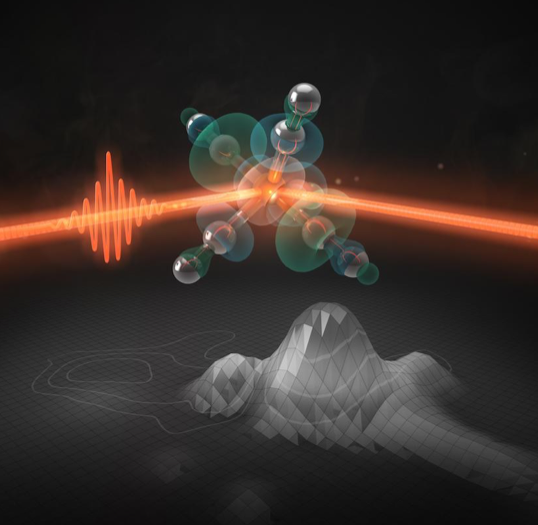
Program Scope: Understanding chemical reactivity in complex molecular systems with ultrafast x-ray and optical sources.
Scientifically, the SPC sub-task focuses on two critical aspects of electronic excited state dynamics emphasizing the fundamental understanding of phenomena relevant to solar energy applications:
(1) We use ultrafast time resolution measurements, simple ligand exchange reactions, and simulation to understand the molecular properties that control excited state relaxation dynamics in coordination compounds.
(2) We use photo-excitation to change the electronic structure and reactivity of inorganic complexes and track site specific changes in metal solvation and coordination dynamics with ultrafast time-resolved measurements and molecular simulation.
Technically, the SPC sub-task focuses on developing and exploiting femtosecond resolution x-ray scattering and spectroscopy methods and complementing them with established femtosecond resolution optical spectroscopy methods.
Hard x-ray Kβ fluorescence spectroscopy investigations of intersystem crossing and internal conversion in 3d transition metal complexes
We have developed ultrafast Kβ fluorescence to characterize the role of metal center excited states in the relaxation dynamics of electronic excited states. Our initial effort has focused on the study photo-induced spin crossover in poly-pyridal Fe(II) complexes. For these molecular systems, the spin dynamics prove to be of particular importance because of the interest in using spin crossover materials in light triggered data storage and iron based dyes as earth abundant light harvesters in dye sensitized solar cells. In both cases the rate of photo-induced spin crossover proves critical, since this rate controls the switching time on the one hand and competes with charge injection on the other. Additionally, the reactivity of photocatalysts depends critically on the charge and spin state of the catalytic metal center, properties well characterized by ultrafast Kβ fluorescence.
Figure 1 shows [Fe(2,2’-bipyridine)3]2+, an archetypical spin crossover complex, as well as a schematic of the experimental design. X-ray spectroscopy, particularly hard x-ray fluorescence and soft x-ray absorption spectroscopy for 3d transition metals, provide sensitive measures of the metal spin state. Ionization of the Fe 1s orbital with a hard x-ray photon above the Fe 1s ionization potential of 7,120 eV, leads to x-ray fluorescence. Fe Kβ fluorescence involves 3p filling of the 1s hole. The strong exchange interaction between the 3d electrons and the hole in the 3p level created by fluorescence makes the Kβ fluorescence spectrum sensitive to the 3d spin moment. This sensitivity can be seen in Figure 1c, where the difference in the Fe Kβ fluorescence spectrum is shown as a function of spin state.

Soft x-ray resonant inelastic x-ray scattering (RIXS) as a molecular-orbital specific probe of photochemistry and photocatalyis
Femtosecond resolution RIXS has been developed as a molecular-orbital specific probe of photochemistry and photocatalyis (Figure 2). RIXS, the x-ray analogue of resonance Raman, provides atom specific information about both unoccupied and occupied frontier orbitals. RIXS has been widely used to characterize the properties of the electronic ground state of materials. Recently, we helped demonstrate the power of RIXS for characterizing the electronic structure of excited states. We used femtosecond resolution Fe L3-edge RIXS to study the archetypical photodissociation of CO from Fe(CO)5 and the generation of the catalytically active Fe(CO)4. Our investigation demonstrated that singlet and triplet reaction channels proceed in parallel for Fe(CO)4. Prior studies have emphasized the significance of one channel versus another, but we have clearly demonstrated that both triplet and singlet forms of Fe(CO)4 occur with appreciable concentration on the sub-picosecond time scale. The ability to track the spin state of metal center excited states also provides the opportunity to investigate the role of spin in catalytic mechanisms. Spin state changes in the catalytic mechanisms of 3d transition metal catalysts have been proposed for a variety of reactions including ligand binding to Fe(CO) and Ni porphyrins, as well as bond activation by heme and non-heme iron-oxo complexes.

Site-specific solvation and coordination dynamics in model photo-catalysts studied with ultrafast x-ray scattering
The reaction environment directly influences the energetics and dynamics of chemical activity. For many catalytic reactions, the activity is dominated by transition metal center that binds the reactant and facilitates the charge transfer events that enables bond formation and dissociation. Understanding the reactivity of catalysts and how the reaction environment governs the reaction dynamics requires a highly local characterization of the metal center. While x-ray spectroscopy provides a powerful approach to atom specific characterization of electronic structure, a powerful local probe of reaction site nuclear structure and dynamics is equally important.
Femtosecond resolution x-ray scattering provides a powerful means of enabling the solute-solvent dynamics to be decomposed into site-specific contributions for the heavy atom scatters in the solute. Equally important, the x-ray scattering signal can be unambiguously compared to molecular dynamics simulations since both methods measure the time dependent pair distribution function.


